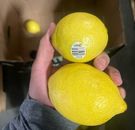 Organic lemon production in North America’s key Fall supplying regions, Mexico, and California, is down this year. “Mexico is suffering from financing issues as well as water problems, causing supplies to drop,” says Gene Loudon with Dovex. A lot of growers in the Tamaulipas region have been in a drought situation for the past 18 -24 months and are running out of water. “Growers can’t afford to drill wells as they are too expensive. At the same time, Mexican banks aren’t lending growers money and they don’t have the financial means to invest in their orchards. Because the upkeep is too expensive, many orchards have been dying from drought and only the biggest players have enough money to maintain their operations,” shared Loudon.
Organic lemon production in North America’s key Fall supplying regions, Mexico, and California, is down this year. “Mexico is suffering from financing issues as well as water problems, causing supplies to drop,” says Gene Loudon with Dovex. A lot of growers in the Tamaulipas region have been in a drought situation for the past 18 -24 months and are running out of water. “Growers can’t afford to drill wells as they are too expensive. At the same time, Mexican banks aren’t lending growers money and they don’t have the financial means to invest in their orchards. Because the upkeep is too expensive, many orchards have been dying from drought and only the biggest players have enough money to maintain their operations,” shared Loudon.
The lack of water is causing lemons to grow smaller. “In addition, quality is not as good as in years past,” Loudon said. All in all, Mexico’s lemon production could be 30 to 35 percent down from production last year. On top of Mexico’s struggles, California also has size issues because of climate change. High temperatures and alternating rainfall between drought and excessive rainfall is causing the state’s harvest to be down an estimated 30 percent from last year.

Strong market
Smaller sizes and lower production are causing the large size lemon market to be strong during a time of year when production levels tend to be abundant. “This is the time when lemon prices typically drop as both Mexico and California are coming into production." However, prices on large sizes are holding good value this season. Larger organic lemons such as 115, 95 and 75s are priced between $42 and $48 per box, which is very good for this time of year. For smaller fruit on the other hand, supply is becoming heavy and prices have dropped to between $28 and $35/box. Loudon believes the market on small fruit may become weaker while on larger sizes, the market may have bottomed out.
Although it's hard to project pricing trends, Loudon expects the market to continue to be pretty good. Argentina and Chile are done for the season, so there are no imports from the southern hemisphere. “Add to that the changing climate and its impact on sizing, and I believe there is a good chance the market will hold up fairly decently until mid-Spring,” he commented. “It’s a very dynamic situation in the market now as supply and pricing changes happen quickly. For growers, success depends on taking advantage of marketing windows. Input costs, climate change, size, price, demand, and supply all weigh much heavier on success than ever before. It looks like growers that have large size lemons with good quality, pricing should be good through the spring. However, when growing small sizes and questionable quality, the season could be a struggle.”
 For more information:
For more information:
Gene Loudon
Dovex
Tel: +1 509-421-2123
[email protected]
www.dovex.com









